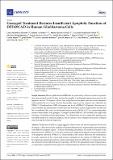Por favor, use este identificador para citar o enlazar a este item:
http://hdl.handle.net/10261/255339COMPARTIR / EXPORTAR:
 SHARE SHARE
 CORE
BASE CORE
BASE
|
|
| Visualizar otros formatos: MARC | Dublin Core | RDF | ORE | MODS | METS | DIDL | DATACITE | |

| Título: | Gossypol Treatment Restores Insufficient Apoptotic Function of DFF40/CAD in Human Glioblastoma Cells |
Autor: | Martínez-Escardó, Laura; Alemany, Montse; Sánchez-Osuna, María; Sánchez-Chardi, Alejandro; Roig-Martínez, Meritxell; Suárez-García, Salvio CSIC ORCID; Ruiz Molina, Daniel CSIC ORCID; Vidal, Noemí; Plans, Gerard; Majós, Carles; Ribas, Judit; Baltrons, María Antonia; Bayascas, Jose R.; Barcia, Carlos; Bruna, Jordi; Yuste, Víctor J. | Palabras clave: | Apoptosis Caspase-activated DNase (DFF40/CAD) Glioblastoma (GBM) Gossypol Nuclear fragmentation/disassembly |
Fecha de publicación: | 8-nov-2021 | Editor: | Multidisciplinary Digital Publishing Institute | Citación: | Cancers 13(21): 5579 (2021) | Resumen: | Glioblastoma (GBM) is a highly aggressive brain tumor and almost all patients die because of relapses. GBM-derived cells undergo cell death without nuclear fragmentation upon treatment with different apoptotic agents. Nuclear dismantling determines the point-of-no-return in the apoptotic process. DFF40/CAD is the main endonuclease implicated in apoptotic nuclear disassembly. To be properly activated, DFF40/CAD should reside in the cytosol. However, the endonuclease is poorly expressed in the cytosol and remains cumulated in the nucleus of GBM cells. Here, by employing commercial and non-commercial patient-derived GBM cells, we demonstrate that the natural terpenoid aldehyde gossypol prompts DFF40/CAD-dependent nuclear fragmentation. A comparative analysis between gossypol- and staurosporine-treated cells evidenced that levels of neither caspase activation nor DNA damage were correlated with the ability of each compound to induce nuclear fragmentation. Deconvoluted confocal images revealed that DFF40/CAD was almost completely excluded from the nucleus early after the staurosporine challenge. However, gossypol-treated cells maintained DFF40/CAD in the nucleus for longer times, shaping a ribbon-like structure piercing the nuclear fragments and building a network of bridged masses of compacted chromatin. Therefore, GBM cells can fragment their nuclei if treated with the adequate insult, making the cell death process irreversible. | Versión del editor: | https://doi.org/10.3390/cancers13215579 | URI: | http://hdl.handle.net/10261/255339 | DOI: | 10.3390/cancers13215579 | E-ISSN: | 2072-6694 |
| Aparece en las colecciones: | (CIN2) Artículos |
Ficheros en este ítem:
| Fichero | Descripción | Tamaño | Formato | |
|---|---|---|---|---|
| cancers-13-05579.pdf | 11 MB | Adobe PDF |  Visualizar/Abrir |
CORE Recommender
SCOPUSTM
Citations
2
checked on 01-may-2024
WEB OF SCIENCETM
Citations
2
checked on 29-feb-2024
Page view(s)
33
checked on 02-may-2024
Download(s)
67
checked on 02-may-2024
Google ScholarTM
Check
Altmetric
Altmetric
Este item está licenciado bajo una Licencia Creative Commons

